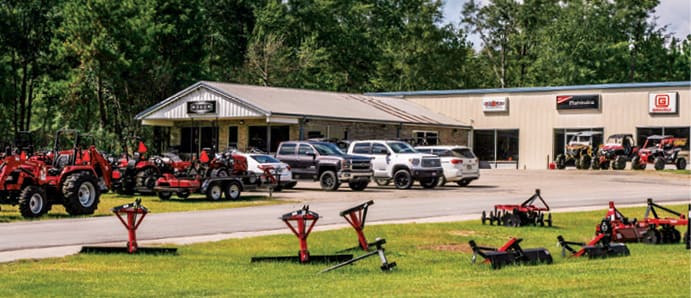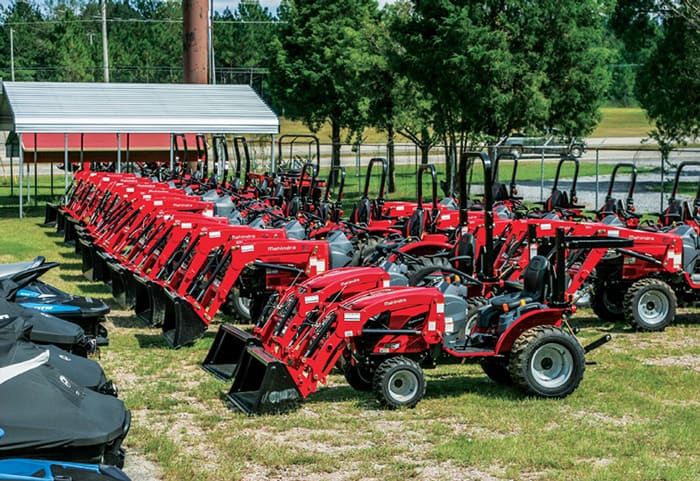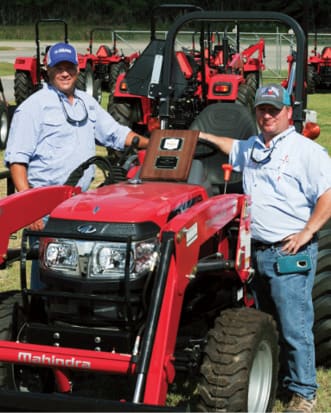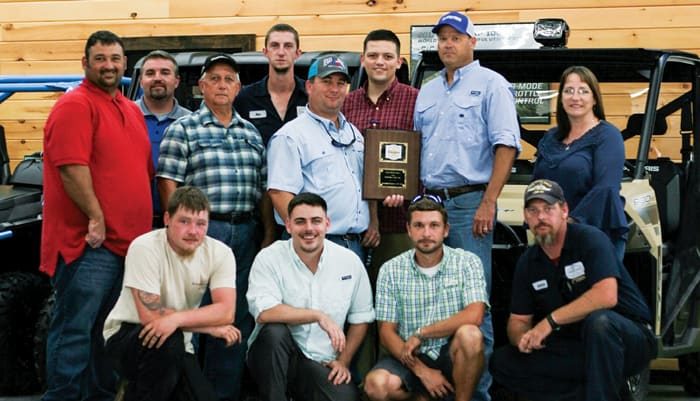Ranchland Tractor & ATV in Saucier, Miss., has conducted a remarkable turnaround, culminating with earning Rural Lifestyle Dealer’s Dealership of the Year in the single-store category. In less than 8 years, David Holman, a new owner from outside the farm equipment business, conquered the monumental challenge of a complete culture overhaul in an older, established dealership.
Holman’s background prepared him for the hard work required to transform his business. He grew up in a small town in northern Mississippi where his family did truck farming. “We raised and sold corn, watermelons and tomatoes from the back of a truck. Our equipment was older 8N and Jubilee tractors. When I bought this place, I had to ask a lot of questions about the operation of the new equipment. Everyone assumed I didn’t know anything about tractors, but I had never run one that was new,” Holman says.
Holman’s employment history also included the banking and manufacturing fields and before purchasing Ranchland, he owned a mortgage company. Business was good, but Holman tired of his chosen occupation. “I got to a point where it wasn’t fun in the financial industry with all the regulations and I was burnt out. So I started looking for other businesses and bought this dealership in 2011.”
Changing the Culture
Holman was purchasing one of the oldest continually running Mahindra dealerships in the U.S., but he was also buying some problems. The previous owner had divested himself of a chain of stores, and the Saucier location was the last to go. Absentee ownership had left a neglected staff and some questionable business practices that Holman was unaware of at the time of purchase. The first red flag was the inventory of new machines, many with parts robbed.
Ranchland Tractor & ATV
Founded: 2011
Location:Saucier, Miss.
Mainline: Mahindra
Shortlines: Bad Boy, Can-Am, Gravely, Polaris, Sea-Doo, Texas Bragg trailers and Woods Equipment
Employees: 12 (3 sales, 1 administration, 6 service, 2 parts)
2017 Revenues: $7,423,816 ($5,751,251 in wholegoods; $1,233,621 in parts; $280,084 in service; and $158,859 in other sales)
2017 Absorption Rate: 87%
Owner: David Holman
Dealership Management System: DX1
Systems Website Vendor: DX1
Holman doesn’t talk much about the early days of the dealership, but there was a time when he wasn’t sure he could continue. He immediately realized he had to change the culture and develop a customer-focused attitude for the dealership. Holman overhauled the staff and facilities and brought in new management ideas, changing a struggling dealership into one worthy of national recognition.
Building the Foundation
In the early days of the dealership, Buford Wingate, who would become the future general manager, was hired as a salesperson. Holman largely credits Wingate with helping turn the dealership around. Holman jokes that the move from sales to management was a battlefield promotion that included no raise, just a different business card. “He was running the dealership anytime I was away, so we gave him the title and let everybody know that he was in charge,” he says of Wingate.
Wingate, like Holman, had not been in the farm equipment business, but managed a trailer dealership and had extensive experience with construction equipment. Both shared similar temperaments and visions for the future, with the first step to address the staff. Holman and Wingate started eliminating staff who were not devoted to their vision of ethics or customer service. They worked long hours together, completing the tasks necessary to grow the business while looking for new staff members.
As the staff grew, Holman realized that he needed to be out of sales. “My favorite thing at the dealership was selling, but getting out of it was the best thing to do. I wanted to be free so when we got busy and things were slacking, I could take care of them. Buyers are like fish; they all feed at once. If I see a salesman trying to juggle too many deals, I jump in and help load the customers, strap things down, get the paperwork done, a lot of admin things,” he says.
Dealer Takeaways
- Changing the culture of a business can be a huge challenge. It may involve hiring all-new personnel who share your values and visions.
- An owner who also sells may not have time to watch the profit picture of a dealership and may damage relations with salespeople by competing for customers.
- Avoid hiring employees who have had multiple jobs in a short period of time. They’re not likely to change and will be gone about the time they’re trained and starting to be productive.
Holman says he resists the urge to meddle with direct employee interaction, instead instructing Wingate on priorities and letting him flesh them out. “Buford’s role is managing everything in the dealership, so employees respect him and his position. He also helps me order wholegoods and we spend a lot of time planning orders because inventory management is tough.”
Wingate’s handling of daily operations gives Holman time to manage the dealership. “Nobody’s going to watch the books like the dealer principal. I check all invoices, which have to be signed off by department heads. Without their initials, I’m not writing a check.
“Numbers are everything. If you’re not managing by the numbers, you’re not managing. You need to know your gross and net margins and your absorption rate, which is a phrase that I never heard before I got into the business. We started off around 28%, now we’re up around 80-85% and are probably as good as we can be. I would love to get to where a Toyota dealership is at 110-115%. I don’t know if that can happen with compact tractors, but it’s a goal.”
Under Holman and Wingate’s leadership, unprofitable lines were eliminated and focus was directed toward growing existing lines and adding new ones with revenue potential. Mahindra, Polaris, Bad Boy and Texas Bragg trailers carried over from the previous ownership. Can-Am, Sea-Doo, Gravely and Woods were added.
Managing Parts & Service
“As we grew, we added a parts manager, Joel Lal, and a service manager, Jason Baker,” Holman says. “Joel tries to maintain the flow of the right parts at the right time, which is almost impossible. You can usually get a part within 3 days, so we don’t do a lot of overnight parts. Jason stays on top of warranty claims and sends the parts back when manufacturers request it.”
“If you’re not managing by the numbers, you’re not managing…”
— David Holman of Ranchland Tractor & ATV
Ranchland’s parts turn rate averages 4 times a year. “We have stale inventory that we inherited when we bought the dealership 7 1/2 years ago and it’s not getting more valuable. We need to determine if it’s worth putting on eBay or offering to another dealer. We do a good job with powersports and lawn mower turns, more so than tractor parts,” Holman says.
The dealership has been in business for a while, but has only sold a high number of machines under Holman’s ownership. “We do a lot of warranty work compared to other dealerships. It’s leveling out, but you don’t make much margin under warranty. Overall, 32-35% is where we tend to come out on parts margins on a monthly basis,” he says.
Holman admits service management is a weak area for him. “I’ve never worked in a shop, but Jason does a great job. We have a service writer who is also a technician and checks in customers, does diagnostics, lines up repairs and orders parts. We have probably more than 40 jobs at any given time and in the spring, it grows to 70-80. Our three technicians have their niche — diesel, small engine and ATV mechanic. They also all help each other and we’re cross training them as we go. We try to get OEM certifications for two people, the technician and either the service writer or service manager. I want them certified because it maintains stability.”
Holman says they’ve worked to improve the quality of the service they offer. “We used to have a lot of come-backs and there’s absolutely no way to make money that way. We’ve slowed down the process and emphasized diagnosing and fixing it right. Everybody wants their technicians to be at 100% efficiency, but if you can get into the 80% range, that’s awesome. We’re always watching technician efficiency and hours billed,” he says.
Holman’s shop is selective in accepting work. “We’re a new dealership and don’t put things together with duct tape and baling wire. If a customer comes in and that’s how he wants it repaired, we don’t want that job. When it leaves, we want to be proud of the work we’ve done. Finding technicians who balance saving the customer money while doing the job right, with the correct parts, is tough.”

Ranchland Tractor & ATV, located in Saucier, Miss., just north of Gulfport, features several product categories. Their largest volume is small tractors and implements for the rural lifestyle market, but they also sell to lawn and garden, personal watercraft and off-road vehicle customers.
Holman says keeping customers informed about repairs is important to service department success. “Most times when we have an unhappy customer, it comes down to a communication issue where we might have not ordered parts in a timely manner or called them about an estimate change. If you communicate properly, you can address 90% of issues. Our service department does a good job at that.”
“I think customers project how they’re treated,” Holman says. “If they don’t feel appreciated, then they come in with an attitude that they have to fight for everything. If you have a customer problem right off the bat, you have to drop everything, take care of the problem and get their product back as fast as you can. Otherwise, they lose confidence in a piece of equipment.”
Growing Sales Volume
Improvements made to the store’s appearance were a first step in building sales. They had asphalt laid around the facility to minimize dust blowing into buildings and to maintain the appearance of new equipment. LED lighting was added in the showroom and shop, as well as outside, to illuminate the business at night.
Holman’s financing experience was valuable in attracting new customers. “We have built relationships with secondary funding sources and finance companies. You can’t misstate income or things like that because once they find out, they won’t trust or deal with you anymore. It’s also important to take care of your finance companies, especially when customers default. Don’t be as concerned about making money for your dealership as much as preserving the lender relationship because it’s way more important than one deal,” he says.

Ranchland Tractor & ATV is one of the oldest Mahindra dealers in North America and they maintain a large stock of tractors and implements on a well-kept grass lot. Newer units are displayed in the back with older inventory moved to the front to ensure it sells first.
Increasing tractor sales continues to be critical, especially since margins are trending lower. “It doesn’t do any good to sell at a low margin to customers hours away from your dealership. You won’t make any money by the time you’ve delivered it and spent time with the customer. I want my population of equipment to be within 30-50 miles of this store. Those people will come back for parts and service. As we focus on the absorption rate, the only thing that will get the rate higher is for the equipment to be locally sold,” he says.
Holman says a bright spot of sales is mowers. They have improved from selling 50 zero-turn mowers a year to closer to 200. The mowing season is long, close to 8-10 months out of the year, and many customers mow twice a week.
Watch the Video Series with Ranchland Tractor & ATV
Go online to view interviews with the Ranchland Tractor & ATV team and see the dealership up close, www.RuralLifestyleDealer.com/DOYarchive. The video series is sponsored by Basic Software Systems.

Powersports are not as profitable, however, in terms of wholegoods sales. They focus now on related areas to improve margins, such as accessories, F&I (finance and insurance) products and extended warranties. Holman realized the dealership was doing customers a disservice by not selling accessories. “Why would someone buy a side-by-side without a roof? The sun is going to bake them or they will get wet from the rain. Having accessories mounted on the units is the way to make margins on powersports,” he says.
Promoting the Dealership
Holman promotes his business with both digital and traditional advertising. “My college degree is in marketing, but back then there was no internet so that game has changed. You used to hear that ads required repetition. I don’t think that applies nearly as much as it used to. You can go in and make a big splash and see results immediately, especially on the digital side,” he says.
Their marketing strategies includes Google AdWords and they focus on staying local. “Faraway customers will just use you to get their local dealer down in price. We keep a 30-40 mile radius. We also use Craigslist and talk radio ads. Mahindra has focused on news/talk advertising for years and I think that people actually listen to the commercials more than they do on music channels,” Holman says.
Their website marketing strategy is to include lots of images — as many as 14 per unit. “We switched two years ago to the DX1 dealer management system, which ties in with QuickBooks and integrates with our website. When we enter a wholegood that we’ve received, it automatically goes online,” Holman says.
Learning from Outside Experience
Holman’s background in the finance industry has also taught him what he doesn’t want to duplicate at the dealership, such as excessive staff meetings. “I’ve stayed in meetings my entire career in finance. At the dealership, I talk to every manager on a daily basis, but we don’t sit down with an agenda. We don’t have enough staff to shut down, so we’d have to do it after hours and I don’t want to keep people late. Everybody knows what their role is and they do a good job.”
The team sets goals toward the end of the year and Holman talks to each manager about accomplishments, what percentage of growth they can achieve and if more employees are needed. He asks for their “wish lists” and checks what the budget will allow.

David Holman (left) owns Ranchland Tractor & ATV of Saucier, Miss. Buford Wingate (right) is general manager. Holman and Wingate transformed an older dealership into an aggressive, customer-focused business with strong ethics and a positive employee culture.
Holman continues to focus on finding employees who share his culture. “When we get a resume or application, it goes to the department head and they determine if the person has the right skill set for the job. I’m not big on job hoppers. Somebody that’s been at one job 9 months and another 6 months will keep doing the same thing. I’ve been told by recruiters that I am wrong, but we put so much effort into schools, certifications and on-the-job training, I want somebody that values the job and our stable work environment. We never have arguments and you rarely hear a curse word or yelling. That’s the way we want to keep it. If somebody comes in causing friction, they have to go. We want a calm environment where everybody likes coming to work and enjoys what they’re doing,” he says.
Benefits include health insurance and a 401k, where the dealership matches up to 5% of an employee’s contribution. “I came from an industry where almost every business had a 401k and health insurance and I wanted to offer those benefits. It took several years to build profitability before offering services like that,” he says.
Looking Ahead
Holman says he is honored to have received the Dealership of the Year, especially considering previous honorees. He’s close friends with former winners Mike Kelly of Kelly Tractor & Equipment, Longview, Texas, 2015 Single-Store Dealership of the Year, and Tony Winslett of Blue River Tractors, Calera, Okla., 2016 Dealership of the Year. They have all served together on Mahindra’s national dealer council.
In charting his own path, Holman takes a cue from his largest supplier’s goal. “Mahindra made a statement in 2015, that by 2020, they would double in size. I came home from the meeting and announced that we would double in size by 2020. Some people were shocked by that statement, but we’re on track to do that. We always want something to shoot for and if it’s not a stretch goal, then it’s not going to force us outside of our comfort zone,” he says.
Holman admits his rapid growth has made him consider expanding to other locations. “It seems like every time I consider that, something comes up and makes me rethink my decision. I am afraid that if we go into another location, that I’ll take my eye off this store and it may not perform as well as it can. It would have to be the right set of circumstances.”
Holman concludes that he doesn’t want to rush the process, sighting an old country song, “One Good Well” about oil wells and greed. He says, “All I need is one good well or one good dealership, and that’s been my philosophy all along.”






Post a comment
Report Abusive Comment